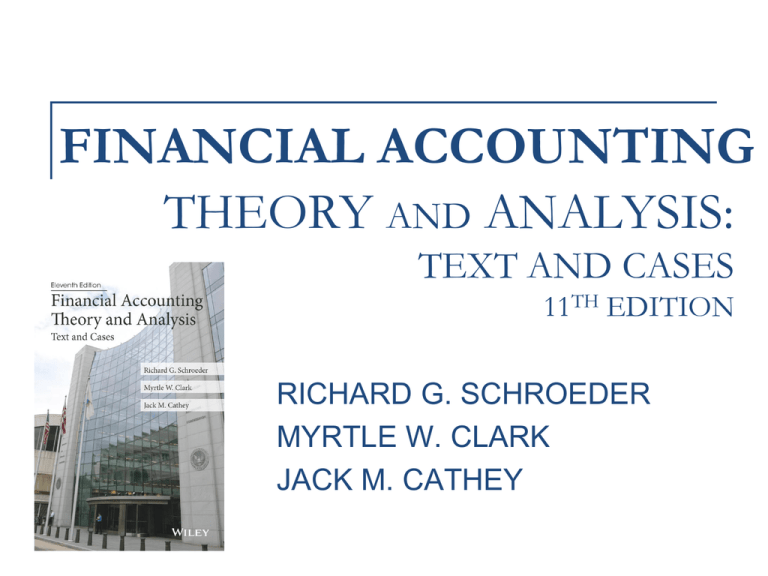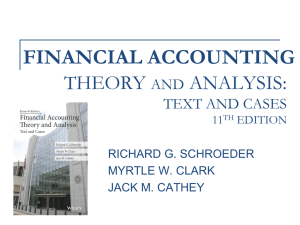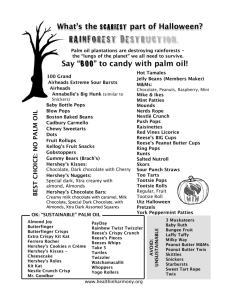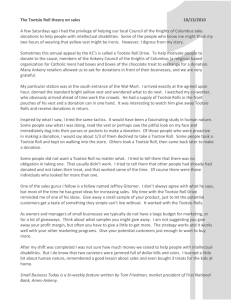
FINANCIAL ACCOUNTING
THEORY AND ANALYSIS:
TEXT AND CASES
11TH EDITION
RICHARD G. SCHROEDER
MYRTLE W. CLARK
JACK M. CATHEY
CHAPTER 7
FINANCIAL STATEMENTS II:
Introduction
Financial reports can be divided into two
categories
1.
Results of the flows of resources over time (flows)
2.
The status of resources at a point in time (stocks)
Statement
of
Retained
Earnings
Balance
Sheet
Past Emphasis
Income statement
Based on the assumption that flows
were more important than stocks
Frequently resulted in the
measurement of stocks at
residual values
FASB
Asset - Liability approach
Changes in balance sheet amounts becoming
more important in income determination
In this chapter
Balance sheet and the associated measurement
techniques for its elements
Statement of cash flows and its evolution over time
The Balance Sheet
Should disclose wealth of a company at a point in
time
Wealth is present value of all
Resources
Obligations
The Balance Sheet
This measurement technique is limited
Consequently, a variety of measurement techniques are
used to measure the elements of the balance sheet
Historical (Historical cost)
Current oriented (Current value)
Future oriented (Expected realizable value)
Balance Sheet Elements
The elements of the balance sheet were defined in SFAC No. 6 as:
Assets
Liabilities
Equity
Definitions arise from the FASB’s asset - liability approach to
income determination
Departure from previous definitions that resulted in valuations
arrived at via the residual effect of income determination
Components of the Balance Sheet
Assets
Current assets
Investments
Property, plant, and equipment
Intangible assets
Other assets
Liabilities
Current liabilities
Long-term debt
Other liabilities
Stockholder’s Equity
Capital stock
Additional paid-in capital
Retained earnings
Asset Valuation
Asset
Measurement basis
Cash
Current value
Accounts receivable
Expected future value
Marketable securities
Fair value
Inventory
Current or past value
Investments
Fair value, amortized cost, or
equity method
Prepaid items
Historical cost
Property, plant and equipment
Depreciated past value
Liabilities and Their Associated
Measurement Techniques
Liability
Measurement
Current Liabilities
Liquidation Value
Long-term &
Other Liabilities
Liquidation Value
or Present Value
Do measurement techniques
bias statements in favor of
current investors?
Stockholders’ Equity Accounts and Their
Associated Measurement Techniques
Account
Measurement basis
Common Stock
Historical Cost
(Par Value vs Selling Price)
Preferred Stock
Historical Cost
Retained Earnings
& Other
Comprehensive
Income
Dependent upon income
Recognition
Fair Value Measurements under SFAS No. 157
(Now FASB ASC 820)
New definition for fair value
Fair value Hierarchy for sources of
information
New disclosures of assets and liabilities
Modification of presumption of transaction
price
Illustration of Tabular Disclosures for Assets
Remeasured on a Nonrecurring Basis
($ in millions)
Description
Fair Value Measurements Using
Year Ended
12/31/XX
Long-lived
assets held
and used
$75
Goodwill
30
Long-lived
assets held for
sale
26
Quoted Prices
in Active
Markets for
Inputs
Identical 1
Assets
(Level 1)
Significant
Other
Observable
(Level 2)
Significant
Unobservable
Inputs
(Level 3)
$75
$(25)
$30
26
Total Gains
(Losses)
(35)
(15)
$(75)
Modification of Transaction Price Presumption
SFAS No 157 did away with presumption
Entities should consider whether certain
factors might indicate that transaction price
does not represent fair value
FASB Staff Position FAS No. 157-4
Some critics of SFAS No.157 maintained that it
caused or exacerbated the 2007–2008 market
crises by forcing a downward spiral of valuations
based on distressed institutions.
They also raised concerns that as a result of
SFAS No. 157 and SFAS No. 115 financial
institutions were forced to book losses on
securities that may have value after the credit
market crisis has passed.
However, proponents of the standard
maintained that suspending or revising SFAS
No. 157 would be a disservice
FASB Staff Position FAS No. 157-4
As a result of these differing viewpoints, financial institutions,
accounting groups, and others requested guidance from the SEC
and the FASB on how to determine fair value measurements in the
then-current economic climate.
On December 30, 2008, the SEC issued a study on fair value
accounting.
This study recommended that existing fair value accounting and
mark-to-market standards, including SFAS No. 157, should not be
suspended.
Later, after some contentious hearings in Congress, where the
FASB’s standard-setting authority was threatened by some of its
members, the FASB amended SFAS No. 157 by issuing FASB Staff
Position (FSP). FAS 157-4 (see FASB ASC 820-10-65).
FASB Staff Position FAS No. 157-4
FSP FAS 157-4 provided guidance on how to
determine when the volume and level of activity
for an asset or liability has significantly
decreased and identified the circumstances in
which a transaction is not orderly.
Subsequently, after considering the significance
and relevance of each of the factors, judgment
should be used to determine whether the market
is active and if a significant adjustment to the
transactions or quoted prices may be necessary
to estimate fair value.
FASB Staff Position FAS No. 157-4
Although proponents and opponents of the amendment
differed on the economic consequences of its adoption,
both expected it to have a major impact.
The expectation was that it would result in the
revaluation upward of troubled assets, especially
mortgage-based securities, by lowering their fair value
hierarchy measurements from Level 2 to Level 3 and
that bank profits might increase by as much as 20
percent.
However, as noted earlier in Chapter 1, a subsequent
study of the impact of the adoption of FSP FAS 157-4 on
seventy-three of the largest banks in the United States
found that a large majority of the banks reported that
adoption of the new requirements had no material impact
Proposed Format of Statement of
Financial Position
FASB-IASB Project (Phase B)
Groups assets and liabilities together
Operating
Investing
Financing
Provides separate section
for stockholders’ equity
Evaluating A Company’s Financial Position
Return on Assets
Net income
Average total assets
Profit margin
Net income
Net sales
Asset turnover ratio
Net sales
Average total assets
Hershey & Tootsie Roll Return on Assets
Hershey
2011
2010
$628,962
($4,412,199 + 4,272,732)/2
=14.48%
$509,799
($4,272,732 + 3,675,031)/2
=12.83%
Tootsie Roll
2011
2010
$43,938
($857,856 + 857,959)/2
=5.12%
$53,063
($857,959 + 838,247)/2
=6.26%
Hershey and Tootsie: Return on Assets
Return on Assets
16.00%
14.00%
12.00%
10.00%
8.00%
6.00%
4.00%
2.00%
0.00%
14.48%
12.83%
6.26%
5.12%
2010
Hershey
2011
Tootsie Roll
Hershey & Tootsie Roll Other Ratios
2011
Profit margin
Asset turnover
Hershey
11.25%
1.40
Tootsie Roll
8.33%
0.62
Evolution of the Statement
of Cash Flows
Prior to 1971
Firms were preparing funds
statements
No guidelines - Methods of preparing statement:
1
2
3
Only two required
financial statements
Cash
Working capital
All financial resources
APB No. 3 - recommended
APB No. 19 - mandatory - all financial resources
APB Opinions 3 and 19
Designed to answer the following questions
1
Where did the profits go?
Why weren’t dividends larger?
How was it possible to distribute dividends
in the presence of a loss?
Why are current assets down when there was a profit?
Why is extra financing required?
How was the expansion financed?
Where did the funds from the sale of securities go?
How was the debt retirement accomplished?
How was the increase in working capital financed?
2
3
4
5
6
7
8
9
Cash Flow Information
Should enable financial statement
users to
Predict the amount of cash that is likely to be
distributed as dividends or interest
Evaluate risk
Presentation of cash flow information assists in
evaluating
Liquidity
Solvency
Nearness to cash
Going concern
Financial flexibility
React to crisis
Historical Perspective
Discussion memorandum
“Reporting Funds Flows, Liquidity, and Financial Flexibility”
Preceded the issuance of SFAS No. 95
Questions raised in this DM included:
1. Which concept of funds should be adopted?
2. How should transactions not having a direct impact on funds be
reported?
3. Which of the various approaches should be used for presenting
funds flow information?
4. How should information about funds flow from operations be
presented?
5. Should funds flow information be separated into outflows for
(a) Maintenance
(b) Expansion of operating capacity, and
(c) Nonoperating purposes
Historical Perspective
Exposure Draft
“Reporting Income, Cash Flows and Financial
Position of Business Enterprises”
SFAC No. 5
“Recognition and
Measurement in Financial
Statements of Business
Enterprises”
Purpose of the Statement of
Cash Flows
Provide relevant information about
cash receipts and cash payments of
an enterprise
Objectives of accounting originally discussed
in SFAC No’s. 1 and 5 led to conclusion
Statement of cash flows should replace the
previously required statement of changes in
financial position
Statement Format
Report changes during an accounting
period in cash and cash equivalents for
Net cash flows from operations
Investing transactions
Financing transactions
Fiscal 2011:
Hershey had a net decrease in cash of
$190,956,000
Tootsie Roll had a net decrease in cash of
$37,364,000
Cash Flows From Operating Activities
Cash effect from transactions
that enter into the determination
of net income
Direct vs Indirect method
SFAS No. 95
exclusive of financing and investing activities
Encouraged companies to report
operating activities in major classes
Hershey vs Tootsie Roll 2011
Hershey $580,867,000
Tootsie $50,390,000
Cash Flows From Investing Activities
Making and collecting loans
Acquiring and disposing of debt
or equity securities of other companies
Acquiring and disposing of property, plant,
and equipment and other productive
resources
Hershey vs Tootsie Roll 2011
Hershey ($333,005,000)
Tootsie Roll ($51,157,000)
Cash Flows From Financing Activities
Results from…
Obtaining resources from owners
Providing owners with a return
of and a return on their investment
Borrowing money and repaying
the amount borrowed
Obtaining and paying for other resources
from long-term creditors
Hershey vs Tootsie Roll 2011
Hershey ($438,818,000)
Tootsie ($36,597,000)
Proposed Format of Statement of Cash Flows
Phase B of FASB-IASB Presentation Project
Expanded version of direct method
Additional disclosures for each category
New schedule, in notes, to reconcile cash
flows to operating income
Proposed Format of Statement of Cash Flows
Categories:
Business
Operating
Investing
Financing
Income Taxes
Discontinued Operations
Equity
Financial Analysis of Cash Flow Information
A major objective of accounting
To provide data allowing the presentation of cash
flows to investors and creditors
To allow evaluation of risk
Net income is not directly
associated with cash
Investors expect return equal to
market rate of interest for investments with
equal risk
discounted future cash flows > investment
Uses of Cash Flow Information
Past cash flows are the best indicators of future cash
flows
Empirical research indicates cash flow information
Has an incremental value over earnings
And is superior to disclosure of changes in working capital
Uses of Cash Flow Information
Net cash provided (used) from operating activities
-Net cash used in acquiring PP&E
Free Cash Flow
Indicator of a company’s ability to pay off debt & maintain growth.
Free Cash Flows
Hershey
Tootsie Roll
2010
2011
2010
2011
$721,855
$256,906
$69,492
$34,039
(in thousands)
Hershey remained positive but metric
deteriorated
Tootsie Roll was also positive in both
years but deteriorated from 2010 to
2011
International Accounting Standards
The IASB has discussed:
1
The statement of financial position
and the various measurement bases used in accounting
Defined assets, liabilities and equity in “Framework for the
Preparation and Presentation of Financial Statements”
The information to be disclosed on the balance sheet and
statement of cash flows in a revised IAS No. 1
The presentation of the statement of cash flows in IAS No. 7,
“Cash Flow Statements”
Discussed the presentation of fair value measurements in
IFRS No. 13, “Fair Value Measurement”
2
3
3
Preparation and Presentation of
Financial Statements
Economic decisions made by users require an evaluation of the ability of
an enterprise to generate cash
Financial position of an enterprise is affected by its
Financial structure
Liquidity and solvency
Capacity to adapt to change (financial flexibility)
Measurement bases include
Historical cost (most common)
Current cost
Realizable value
Present value
Definitions of assets, liabilities and equity are similar to
U. S. GAAP
IAS No. 1: Presentation of
Financial Statements
Recommends disclosures similar
to U. S. GAAP
Revised IAS No. 1
Requires assets to be classified as current and noncurrent
Recognizes that there are differences in the nature and function of
assets, liabilities, and equity
Unless a liquidity presentation provides more relevant and reliable
information
So fundamental that they should be presented on the face of the
balance sheet.
Specifies specific categories of items to be disclosed
IAS No. 7
Operating, financing and investing
activities are to be disclosed
Indirect or direct method of disclosing
operating activities may be used
Stated a preference for the direct method.
Cash flows from extraordinary items
required to be disclosed separately as
operating, investing or financing.
Acquisition or disposal of subsidiaries
Will significantly change presentation of
statement of cash flows.
IFRS No. 13
Applies to IFRSs that require or permit fair value
measurements or disclosures
IFRS No. 13 achieves convergence with U. S.
GAAP. Specifically, it:
Defines fair value
Provides framework for measuring fair value
Requires disclosures about fair value measurements
Attempts to provide consistency and comparability
in fair value measurements and related
disclosures.
IFRS No. 13: Fair Value Hierarchy
Level 1 inputs
Level 2 inputs
Quoted prices in active markets for identical assets or
liabilities
Inputs other than quoted market prices that are observable
for the assets or liability
Level 3 inputs
Unobservable inputs for the asset or liability
Level 3
Level 2
Level 1
End of Chapter 7
Prepared by Kathryn Yarbrough, MBA
Copyright © 2014 John Wiley & Sons, Inc. All rights reserved.
Reproduction or translation of this work beyond that permitted in
Section 117 of the 1976 United States Copyright Act without the
express written consent of the copyright owner is unlawful. Request
for further information should be addressed to the Permissions
Department, John Wiley & Sons, Inc. The purchaser may make backup copies for his/her own use only and not for distribution or
resale. The Publisher assumes no responsibility for errors,
omissions, or damages, caused by the use of these programs or from
the use of the information contained herein.







